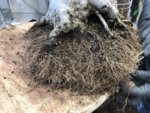Personally, I think the colander is wasted if you wait 2-3 years to cut the roots.
I would plant deciduous in something like an anderson flat and repot no less than every 2 years. I don't see the advantage of colanders here. I can't comment on Tropicals, Anthony has loads more experience there.
Conifers go in colander and follow the Bonsai Today timelines for repotting (generally every few years). If you use the escape method, lift and cut all roots no less than once per year, or you'll just get a bunch of thick roots and defeat the purpose of the colander.
I would plant deciduous in something like an anderson flat and repot no less than every 2 years. I don't see the advantage of colanders here. I can't comment on Tropicals, Anthony has loads more experience there.
Conifers go in colander and follow the Bonsai Today timelines for repotting (generally every few years). If you use the escape method, lift and cut all roots no less than once per year, or you'll just get a bunch of thick roots and defeat the purpose of the colander.




